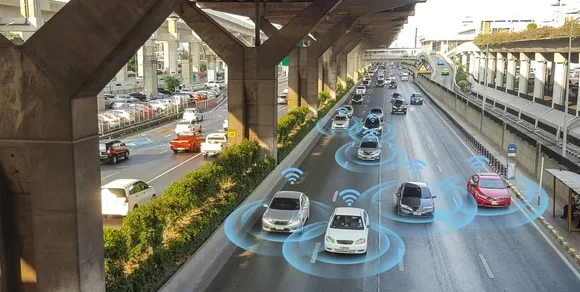
Intelligent transport system is an important requirement in India and adopting C-V2X (Cellular Vehicle to Everything) technology based on 3GPP specifications will create a harmonised eco-system with the Cellular networks
Intelligent Transport Systems are a suite of public transport planning, operations management and customer service applications that are enabled by advanced information and communications technologies. They act to enhance the effectiveness, efficiency, and usability of the public transport service to the benefit of public transport authorities, operators, and passengers. Safer road infrastructure, safer vehicles, and safety of vulnerable road users using ITS is part of National Road Safety Policy.

Sushil Kumar Dy. Director General (IoT), TEC, Department of Telecommunications, Ministry of Communication
NDCP 2018 has also mentioned about developing the market for IoT/ M2M connectivity services in sectors including Agriculture, Smart Cities, Intelligent Transport Networks, Multimodal Logistics, Smart Electricity Meter, Consumer Durables etc. incorporating international best practices.
TEC has released 20 Technical Reports in M2M/ IoT domain covering various verticals, communication technologies and security. Out of which, following technical reports covered various aspects of the intelligent transport system including V2X.
- IoT/ ICT Standards for Smart Cities, released in 2023
- Emerging Communication Technologies & Use Cases in IoT Domain, released in 2021
- V2V / V2I Radio communication and Embedded SIM, released in Nov. 2015
- M2M Enablement in Automotive (Intelligent Transport System) Sector, released in May 2015
Technical Report Emerging Communication Technologies and Use cases in IoT domain covers the communication technologies namely 5G, Wi-Fi 6, WiFi 6E, WiFi HaLow, Bluetooth Mesh and some important use cases such as Intelligent transport system (Connected vehicles, C-V2X based on 3GPP specifications); Private Industrial Network (Smart factories, Industry 4.0), Smart homes etc. This report provides recommendations on spectrum and regulatory related aspects, which may be quite useful in the development of eco-system in India.
Brief of all the reports is available in TEC initiatives in M2M/ IoT domain: An overview. All the Technical Reports1 are available on TEC website.
Recently the study has been completed on technologies and standards for ITS in a multi stakeholders working group formed by TEC. The document is expected to be released shortly.
The above figure illustrate the various applications, which may be provided as a part of Intelligent Transport System:
3GPP released LTE C-V2X specifications in its Release 14 in 2017, which establishes the foundation for safety use cases.
Vehicle to Everything is also commonly referred to as V2X. V2X employs two complementary transmission modes:
- Short-range direct communications (works independently of the cellular networks in dedicated Spectrum in 5.9 GHz (5875-5925 MHz) band)
o Vehicle – to – vehicle (V2V) for collision avoidance safety system etc.
o Vehicle – to – Infrastructure (V2I) for traffic signal timing / priority etc.
o Vehicle – to – Pedestrian (V2P), such as cyclists and pedestrians for safety alerts etc.
- Long-range network communications (works in traditional cellular operator bands and may require a mobile connection)
o Vehicle – to – network (V2N) for real time traffic routing / cloud services in which C-V2X employs the conventional mobile network
The 3GPP C-V2X provides not only the direct communication (V2V, V2I, and V2P) but also the network-based communication V2N to provide network assistance for safety related features. The communication links enable a vehicle to receive information about road conditions and traffic in the area, beyond the driver’s line of sight. These technologies complement the traditional technologies within a vehicle that are typically visual line-of-sight (e.g., Sensors, ADAS, LiDAR, etc.).

- Short-range direct communications
o Vehicle – to – Vehicle (V2V) for collision avoidance safety system etc.,
o Vehicle – to – Infrastructure (V2I) for traffic signal timing / priority etc.
o Vehicle – to – Pedestrian (V2P), such as cyclists and pedestrians for safety alerts etc.
- Long-range network communications
o Vehicle – to – network (V2N) for real time traffic routing / cloud services in which C-V2X employs the conventional mobile network
3GPP Release 14 (published in 2017) specifications for LTE based C- V2X provide improvements over 802.11p / DSRC technology for active safety use cases and beyond. 3GPP Rel 15 (published in 2018) provides further improvement in C-V2X safety, range, and reliability.
3GPP Rel-16 (published in 2020) provides specifications for 5G and NR based C-V2X, with continuing evolution path for future releases.
Further, 3GPP Release 18 is currently working on standardizing aspects related to side link based positioning, improved co-channel co-existence between LTE & NR V2X, etc. The 3GPP based access layer technologies are in advanced stages of commercialization in several countries across the world.
A typical C-V2X implementation will require both the radio layer (Access layer) and the higher (application layer) stack. The Access layer specifications are published by 3GPP (e.g., LTE based C-V2X, as specified in 3GPP Release 14 (published in 2017), and Release 15 (published in 2018), and so on.). The Applications and protocols are developed by ETSI / Society of Automotive Engineers (SAE).
Integrating short-range C-V2X direct communications with the cellular networks for longer-range communications can deliver measurable safety enhancements and traffic efficiency benefits, bringing the transportation and automotive industries to the cusp of a massive technology transformation.
C-V2X Use cases
Some of the important C-V2X Use cases are Forward Collision Warning, Emergency Electronic Brake Lights, Do Not Pass Warning, Left Turn Assist, Intersection Movement Assist, Blind Spot Warning/Lane Change Warning, Emergency Vehicle Alert, Platooning etc.
Industry Associations
5GAA (5G automotive association) is a cross industry consortium connecting the vehicle manufacturers and telecom industry to work closely together to develop end to end solutions for future mobility and transportation services. 5GAA has over 130 member companies representing Global automakers, mobile operators, semiconductor companies and test equipment vendors. 5GAA is working on Intelligent transport solutions based on C-V2X technology and several trials are already in progress in several countries.

Spectrum allocation
C-V2X is designed to work in ITS 5.9 GHz spectrum band for vehicles to talk to each other on harmonized dedicated spectrum. C-V2X support in ITS band was added in 3GPP Release 14 published in 2017. V2V, V2I and V2P services require low latency network in 5.9 GHz band and is independent of cellular communication. V2N operates through cellular network. C-V2X has widespread support within the mobile and automotive industries.
The Federal Communication Commission (FCC) USA has issued a directive in November 2020 to allocate the upper 30 MHz of the 5.9 GHz (5.895 –5.925) ITS band to C-V2X technology that gives the C-V2X industry the green light to deploy C-V2X Roadside Units (RSU) and Onboard Units (OBU). This decision was affirmed in August 2022.
The Ministry of Industry and Information Technology China also issued the administrative regulations on the use of 5.905-5.925 GHz Spectrum for Direct Connected Communication on the Internet of Vehicles, which established dedicated C-V2X spectrum with a total bandwidth of 20 MHz.
In India, the footnote IND 29 (page no. 201) of National Frequency Allocation Plan (NFAP-2022) allows the V2X technologies/Intelligent Transport Systems in the frequency band 5875 – 5925 MHz.
Close coordination among related Ministries/ Departments namely DoT/ TEC and MoRTH is required for the implementation of Intelligent transport system using cellular networks to ensure timely and effective deployment of services in the country.
 TrafficInfraTech Magazine Linking People Places & Progress
TrafficInfraTech Magazine Linking People Places & Progress